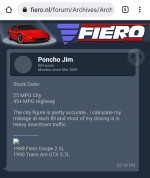Sean buick 76
New member
Amazing thread! I stumbled onto this forum due to Paul Muller, he has been a huge help to me as well with Buick’s. Amazing projects, super cool! I will check out your rocket stove website! Keep the dream alive!
....then he said the engine also had a "checkvalve" in the form of turbocharger putting out 12lbs of boost, and it became pretty obvious the boost was what doubled the hp.
He also said the air/fuel mixture is heated to over 450 degrees which is about 910 degrees absolute.
Let's say that the ambient outside temp is 75 degrees. That will be 535 degrees absolute.
910 divided by 535 is 1.7
A pressure ratio of 1.7 at sea level is 10.3 psi.
This means that it takes at least 10.3 psi of boost to compress a 450 degree air/fuel charge so it has the same density at sea level without boost at 75 degrees.
So the 12 lbs of boost is needed to restore the hot air density back to ambient air density with no real gain in power due to air compression (boost).
The turbocharger was truly a check valve allowing the intake air to be heated without losing density.
When the fuel is vaporized completely and run as lean as needed combined with almost no thermal energy loss from a radiator cooling system and recovered energy from the exhaust by way of the turbocharger, I would expect very high gas mileage.

Well let's see.Either way, Smokey said a lot of things. Most of it was pure bullshit & deception that he was known to spew. I'm not listening to the physics that he wants people to believe is happening. He was known to point to facts as a means of getting peoples attention away from what he was hiding. For instance, when the original interviewer pointed out the turbo (i found it was actually pushing 15psi; which to me is the most obvious reason the engine hp doubled) & Smokey got mad & screamed "its not a turbocharger! Its a homogenizer!". Your numbers might be right about the physics, but Im feeling that there are more complicated things at play here.
Yes it comes with its own set of problems to be solved but that is part of the fun.
I don't feel that you have been attacking me and I have no problem with you playing the Devil's advocate.I dont want you to think Im attacking you. I've studied this engine years ago & am purposely playing the devils advocate while hoping someone actually shows me this engine is possible.

At the time of the oil embargo any increase in fuel mileage was a big deal and I feel that Smokey played into that.

Thanks for sharing your most recent successes along with the ESTC conference video.
Great presentation.
I also appreciated some of your background information and plans for future projects.
I'm looking for your thoughts on the forced induction Bourke engine.
You shared the idea of using a supercharger as part of the induction system since both sides of the piston are being used for combustion.
Superchargers have parasitic losses and when added to a system, the total system efficiency decreases.
Some superchargers are more efficient than others but still have efficiency losses.
It's been some time so I'm hoping there is more baseline information to work with.
Is there enough thermal energy from the exhaust of the Bourke engine under very light loads to vaporize the fuel before entering the engine?
I realize there is less fuel to vaporize under light loads, but the intake air volume is still the same and the air temperature would drop from a heat exchanger as the engine load decreases.
1-2 psi of intake manifold pressure works on a 4 stroke engine but not on a two stroke engine.DeltaV said:
My train of thinking is to use a supercharger to push in just enough air to fill the cylinders, but at less than 1-2 PSI at most. This way the "supercharger" is working more like a scavenging pump, or external "intake" stroke so to speak.


